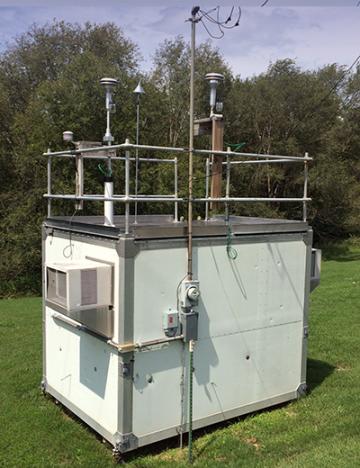The air monitoring station at Hillcrest High School helps the Missouri Department of Natural Resources determine exposure to air pollutants of a segment of the Springfield population. Specifically, it meets the federal requirement to monitor exposure to ozone of a population of the Springfield metropolitan statistical area (MSA). The Hillcrest High School station began monitoring PM10 and PM2.5 concentrations, too, in April 2015 when the department relocated monitors at the Missouri State University (MSU) station to Hillcrest High School because of construction at the MSU site.
Pollutants
Ozone Pollutant
The primary National Ambient Air Quality Standard for ozone is 0.070 parts per million averaged over eight hours (annual fourth-highest daily maximum 8-hour concentration, averaged over three years). The federal ozone season for monitoring runs from March 1 to Oct. 31.
- Eight-hour ozone design values
- Four highest eight-hour ozone values from beginning of ozone season
- Running list of sites with exceedances from beginning of season
- Monthly number of exceedances
- Daily maximum average eight-hour concentration for each site from beginning of season
- Map of Missouri's ozone monitoring sites
Technical issues can affect ability to deliver quality data. Access a table of symbols with explanation of the problems they represent.
- Ozone data in first two columns - "P" stands for primary monitor. "S" stands for secondary monitor.
- Data from 10 days ago through current date
- Central Standard Time
- Concentration of ozone in parts per million (ppm)
Fine Particulate Matter (PM 2.5)
Departmental information about particulate matter (PM)
- Description of two groups of particulate matter: PM2.5 and PM10
- 1997, 2006 and 2012 standards for PM2.5 plus related documents
- 2006 PM10 standard and pertinent documents
- Annual PM2.5 design values
- 24-Hour PM2.5 design values
- Map of PM2.5 sites
Technical issues can affect ability to deliver quality data. Access a table of symbols with explanation of the problems they represent.
- PM2.5 data in sixth column.
- Data from 10 days ago through current date
- Central Standard Time
Particulate Matter (PM 10)
Departmental information about particulate matter (PM)
- Description of two groups of particulate matter: PM2.5 and PM10
- 1997, 2006 and 2012 standards for PM2.5 plus related documents
- 2006 PM10 standard and pertinent documents
- Information about standard and monitoring
- Expected number of exceedance days in a year
- Map of PM10 monitoring stations
Technical issues can affect ability to deliver quality data. Access a table of symbols with explanation of the problems they represent.
- PM10 data in seventh and eighth columns
- Data from 10 days ago through current date
- Central Standard Time

3319 N Grant Ave
Springfield, MO 65803
United States
Air Pollution Control Program
Division of Environmental Quality
P.O. Box 176
Jefferson City, MO 65102-0176
United States
